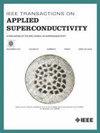Characterization and Modeling of a Large Area Spiderweb Bolometer for CMB Observation
IF 1.7
3区 物理与天体物理
Q3 ENGINEERING, ELECTRICAL & ELECTRONIC
引用次数: 0
Abstract
We present the characterization of a prototype TES bolometer suitable for Cosmic Microwave Background (CMB) measurements. This detector consists of a double layer (Ti-Au) superconducting film thermally coupled to a large area (8 mm diameter) spiderweb absorber, fabricated at INFN Genova. Thermo-electrical properties of the superconducting film are measured by means of four-wires and two-wire setups. These include Resistance vs Temperature curve, which allows us to determine the critical temperature, other parameters of the transition, and the critical current. From the measurement of the critical retrapping current, we can estimate the thermal conductance (求助全文
约1分钟内获得全文
求助全文
来源期刊

IEEE Transactions on Applied Superconductivity
工程技术-工程:电子与电气
CiteScore
3.50
自引率
33.30%
发文量
650
审稿时长
2.3 months
期刊介绍:
IEEE Transactions on Applied Superconductivity (TAS) contains articles on the applications of superconductivity and other relevant technology. Electronic applications include analog and digital circuits employing thin films and active devices such as Josephson junctions. Large scale applications include magnets for power applications such as motors and generators, for magnetic resonance, for accelerators, and cable applications such as power transmission.
 求助内容:
求助内容: 应助结果提醒方式:
应助结果提醒方式:


